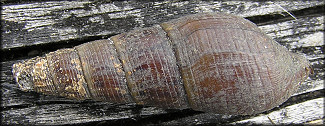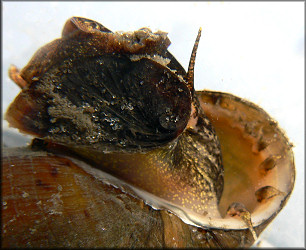| A New Species For The Northeast Florida Aquatic Checklist And Another Musing | |
| By Harry G. Lee | |
|
My home phone rang early Saturday afternoon, Oct. 30, 2006. Calling on his cell phone was Bill Frank, who had just discovered a provident new collecting station, and he was perplexed by a giant (39 mm.) awl-shaped snail on the shore of an artificial pond in the Julington Creek Plantation community in Fruit Cove near Mandarin. His specimen, although dead and missing several of its apical whorls, was a giant example of Melanoides turricula (I. Lea, 1850) according to Thompson (1984: fig. 44). Originally named Melania turricula, the species was based on material from Luzon, Philippines. Although never illustrated by its author, it is a well-recognized form, which some malacologists think may be a smoother, spirally-grooved form of Melanoides tuberculata (Müller, 1774), a non-native species found for many years in Duval Co. Since the two are recognized as separate species by Turgeon, Quinn, et al. (1998), who acknowledge its presence elsewhere in Florida, we shall add M. turricula to our northeast Florida checklist. |
|
 |
 |
|
Specimen collected at pond, Julington Creek Plantation, St. Johns Co., FL (39.4 mm.) |
|
Since there is no consensus on the
gender of the generic epithet even in the most authoritative
literature (e. g., Turgeon, Quinn et al., 1998 lists
Melanoides tuberculatus [sic] and M. turriculus [sic]),
a nomenclatorial analysis of Melanoides Olivier, 1804 is
indicated. Article 30.1.4.4 of the Rules (ICZN, 1999)
indicates each -oides generic level taxon is to be treated as
masculine "unless its author, when establishing the name, stated
that it had another gender or treated it as such by combining it
with an adjectival species-group name in another gender form." Unfortunately the Olivier work is exceedingly rare and apparently
not available on the Internet, so I turned to a time-honored source
of information on higher-level taxonomy and nomenclature, Wenz. In
that work (Wenz, 1939: 713) appears the passage: "Melanoides
Olivier, 1804 ...... Monotypus: M. fasciolata Olivier =
tuberculata (O. F. Müller) [Nerita]." Thus it appeared
that the genus may well have been treated as feminine ab origine.
The prodigious website
"2400 years of malacology" by
Eugene V. Coan, Alan R. Kabat and Richard E. Petit at
[accessed Sept. 30, 2006], cites a paper that analyzed Olivier's
opera and collections. In this report by Tillier and Mordan (1983:
158; pl. 5, fig 2), four syntypes of Melanoides fasciolata
Olivier are mentioned, and one is illustrated. Furthermore, the
authors confirmed that combination Melanoides fasciolata was
used by Olivier (1804: 40, pl. 31, fig. 5). Thus there are two
independent lines of evidence indicating an unambiguous treatment of
the genus epithet as a feminine noun by its author.
Unfortunately the Olivier work is exceedingly rare and apparently
not available on the Internet, so I turned to a time-honored source
of information on higher-level taxonomy and nomenclature, Wenz. In
that work (Wenz, 1939: 713) appears the passage: "Melanoides
Olivier, 1804 ...... Monotypus: M. fasciolata Olivier =
tuberculata (O. F. Müller) [Nerita]." Thus it appeared
that the genus may well have been treated as feminine ab origine.
The prodigious website
"2400 years of malacology" by
Eugene V. Coan, Alan R. Kabat and Richard E. Petit at
[accessed Sept. 30, 2006], cites a paper that analyzed Olivier's
opera and collections. In this report by Tillier and Mordan (1983:
158; pl. 5, fig 2), four syntypes of Melanoides fasciolata
Olivier are mentioned, and one is illustrated. Furthermore, the
authors confirmed that combination Melanoides fasciolata was
used by Olivier (1804: 40, pl. 31, fig. 5). Thus there are two
independent lines of evidence indicating an unambiguous treatment of
the genus epithet as a feminine noun by its author. Recalling the tedious analysis of the gender of Toxolasma
Rafinesque, 1831 and the lesson learned from the misleading
information that an Internet search generated (Lee, 2006; <
http://www.jaxshells.org/lilliput.htm>), curiosity got the
better of me, and I Googled the names Melanoides tuberculata
(Müller, 1774) (feminine) and Melanoides tuberculatus (Müller,
1774) (masculine). This produced about 579 and 605 "hits"
respectively. Although based on democratic principles, the Internet
is far from a rigorous arbiter of sound binominal nomenclature, and
it again gave the nod to an improper name according to the Code,
but at least it wasn't so resoundingly off the mark as in the
Toxolasma "experiment."
Recalling the tedious analysis of the gender of Toxolasma
Rafinesque, 1831 and the lesson learned from the misleading
information that an Internet search generated (Lee, 2006; <
http://www.jaxshells.org/lilliput.htm>), curiosity got the
better of me, and I Googled the names Melanoides tuberculata
(Müller, 1774) (feminine) and Melanoides tuberculatus (Müller,
1774) (masculine). This produced about 579 and 605 "hits"
respectively. Although based on democratic principles, the Internet
is far from a rigorous arbiter of sound binominal nomenclature, and
it again gave the nod to an improper name according to the Code,
but at least it wasn't so resoundingly off the mark as in the
Toxolasma "experiment."So Melanoides turricula (I. Lea, 1850), the Fawn Melania, has been installed on the Northeast Florida Aquatic Mollusk Checklist joining 60 other species and becoming the seventh non-native constituent in the group. Acknowledgements: I thank Bill Frank for his yeoman field work and Dick Petit for his patiently consistent guidance through the literature. ICZN (International Commission for Zoological Nomenclature), 1999. International code of zoological nomenclature fourth edition. I.C.Z.N., London. pp. 1-306 + i-xxix. Lee, H. G., 2006. Musings on a local specimen of Toxolasma paulum (I. Lea, 1840), the Iridescent Lilliput. Shell-O-Gram 47(5): 3-6. Sept.-Oct. Olivier, G. A., 1804. Voyage dans l'empire Ottoman, l'Egypte et la Perse, fait par ordre du gouvernement pendant les six premières années de la république Tome second. Agasse, Paris. 1-466; Atlas, 2d livraison: vii + pl. 18-32. [not seen] Thompson, F. G., 1984. The freshwater snails of Florida A manual for identification. University of Florida Press, Gainesville. x + 1-24. Tillier, S. and P. Mordan, 1983. The conchological collections of Bruguière and Olivier from the Ottoman Empire (1792-1798). Journal of Conchology 31(3): 153-160. Turgeon, D. D., J. F. Quinn, Jr., A. E. Bogan, E. V. Coan, F. G. Hochberg, W. G. Lyons, P. M. Mikkelsen, R. J. Neves, C. F. E. Roper, G. Rosenberg, B. Roth, A. Scheltema, F. G. Thompson, M. Vecchione, and J. D. Williams, 1998. Common and scientific names of aquatic invertebrates from the United States and Canada: mollusks, 2nd edition. American Fisheries Society, Special Publication 26, Bethesda, Maryland. ix + pp. 1-509 + 16 pls. (unpaginated). Wenz, W., 1938 - 1944. Handbuch der Paläzoologie, herausgegeben von O.H. Schindewolf. Band 6. Gastropoda Teil 1: Allgemeiner Teil und Prosobranchia 1-1639 + xii + 1-9: Teil 1 Teil 2 Teil 3 Teil 4 Teil 5 Teil 6 Teil 7 |
|